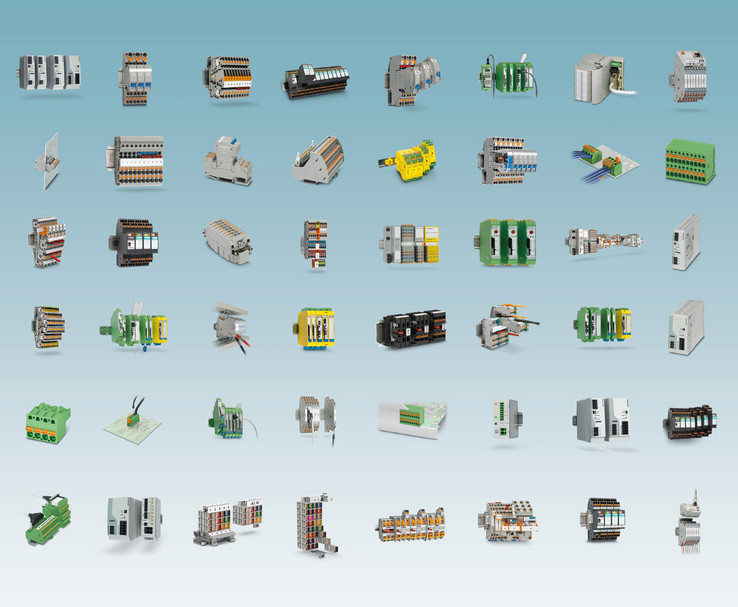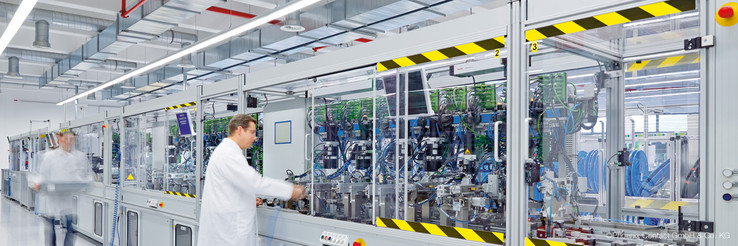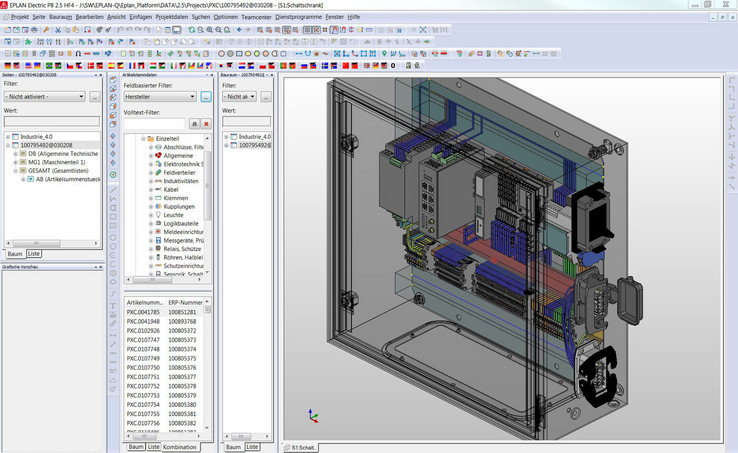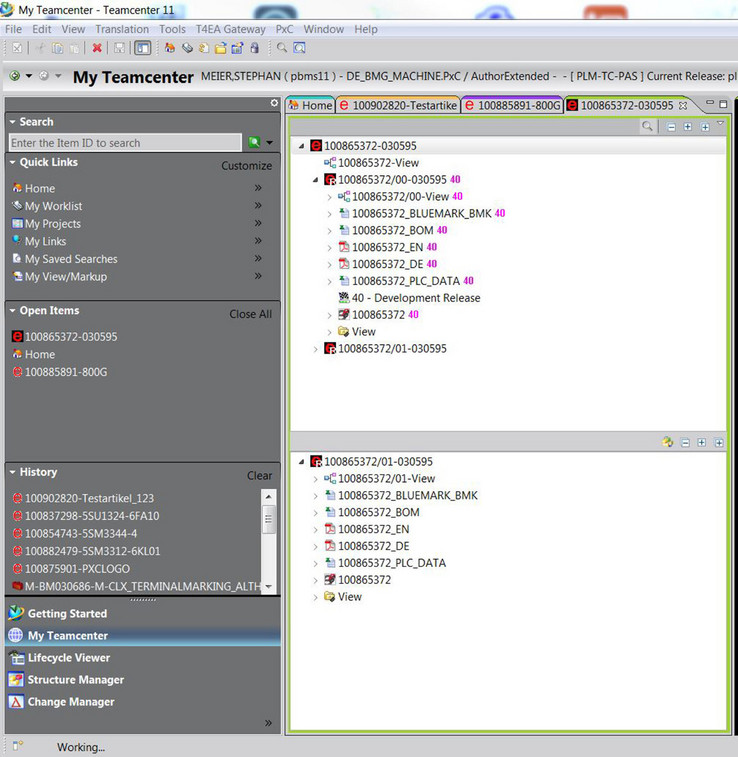Development and design engineering consistency
Linking EPLAN Electric P8 and Siemens Teamcenter
Electrical design engineers from Phoenix Contact have been using the EPLAN Platform for years. What's now new is a link to Teamcenter and the application of a consistent Product Lifecycle Management system. The company's "pilot" is its own mechanical engineering department – and initial experiences are very positive.
What impact will digitalisation have on industrial production? The management at Phoenix Contact can give answers to this question from two different perspectives. Firstly, as a leading global manufacturer of automation systems, the company is intensively involved in pushing forward digitalisation and supports its customers with components, systems and solutions which, for example, enable greater manufacturing agility and efficient production for small batch sizes
Full digitalisation in development and production
Phoenix Contact is also a user of developments in digitalisation– i.e. as a production company with extensive manufacturing capacity in 10 countries. It produces components and systems for connection and automation technology, e.g. terminal blocks and special-purpose terminals, connectors, electronic interfaces, and energy supply and automation systems based on Profinet, Ethernet, wireless and other bus systems.
Their value chain goes even one step further: at its Blomberg site, the company has an in-house mechanical engineering department with 160 personnel who mainly develop and construct machines for the global production facilities. Phoenix Contact is taking the opportunity here to develop production digitalisation in-house.
Interface between EPLAN Electric P8 and Teamcenter
Mechanical engineering designers within the company naturally use the latest design tools. The engineer Stephan Meier, Senior Specialist CAE at Phoenix Contact reports: "We have been using the EPLAN Platform since 2004". For electrical design, EPLAN Electric P8 is used as well as the EPLAN Pro Panel module for designing smaller switch cabinets and boxes in 3D. Engineers also work with the EPLAN Fluid module for fluid design and EEC One software for automated electrical design engineering.
The latest extension to the EPLAN Platform is an interface to Teamcenter, the world's most used PLM system of Siemens PLM Software. This interface is part of a "springboard" for implementing Teamcenter across the whole of Phoenix Contact. Optimal preparation has taken place and was necessary due to indications that the existing PLM system would not be supported in the future.
Aim: Cross-company usage of Teamcenter
Stephan Meier, who is responsible for the "EPLAN Integration in Teamcenter" project says: "Our aim is to portray every product, along with all the associated information, in the new PLM system and to integrate all disciplines in the developmental process – electrical engineering, mechanical engineering, and software programming".
Following a 2-year evaluation phase, Phoenix Contact opted for Teamcenter and commenced modelling the system with support from PLM experts. A lot of time was invested into this process. Stephan Meier: "Implementing PLM is as complex as installing SAP. Furthermore, it involves setting specifications that need to be applicable for many years ahead. Extreme care is therefore required".
In-house mechanical engineering department as pilot user
The in-house mechanical engineering department was chosen as a pilot user for the interface as well as for general application of the new PLM system. There were good reasons for this. Stephan Meier: "In a company with 14,800 personnel, it is a project that can be kept manageable". Furthermore, the machinery, whose data is portrayed within the PLM, remains in-house. The range of systems developed by mechanical engineering is extensive. These include systems for joining and assembling as well as production facilities and whole lines ranging from the manufacturing of terminals through to complete automation systems.
Centralised platform for all product-based data
The basis for all Phoenix Contact's production and design data will in future be the PLM system. Stephan Meier: "We then have just one central source of data. Even the quotations, which are compiled by mechanical engineering for the separate company departments, are created within Teamcenter." Teamcenter also stores templates and basic projects.
When a designer carries out electrical engineering for a machine, he/she accesses data from Teamcenter – without however noticing it because access to the PLM data takes place from EPLAN. Design engineers are therefore not required to be experts in using Teamcenter and access it only through user interfaces which they are already familiar with.
Cross-functional modules make design engineering easier
For mechanical engineering at Phoenix Contact, EEC One is the "store" for macros and electrical engineering standards. Small units have intentionally been selected for the module's granularity. Stephan Meier: "Virtually all of our machines are equipped with feeding systems. We have however not defined a module for the feeding systems but instead for their components such as electromagnetic cylinders, position switches and grippers. This gives the advantage of being able to use such components for other functions". For example, macros with all the relevant data for cylinders are stored which can then be automatically linked in schematic generation.
"We want to generate schematics not draw them"
With this and other approaches, Phoenix Contact are nearing their goal of automating electrical design as much as it is possible and where it makes sense to do so. "We want to generate schematics not draw them". Currently, this accounts for around 50 to 70% of the work, depending on the project. Electrical design engineers need not concern themselves about duplicate work and then have time for actual design tasks. This reduces development time, another goal of Phoenix Contact. Stephan Meier: "Projects with a one-year duration, which used to be common, don't happen any more – especially because we use the machines to make our own products, products which need to be launched onto the market as quickly as possible. Any time savings we can make during development are therefore important."
Mechatronics in action
Mechatronic aspects in design were also important factors for Phoenix Contact when implementing the new PLM system. And these are included in the Teamcenter. For example, the PLM system brings together data from mechanical and electrical engineering into a common bill of material which is then transferred to the ERP system. Greater emphasis is also given to mechatronics at the process level because, in addition to a common IT platform, there is also now a cross-discipline development team.
Clear structures in data and revisions management
In the exchange of data between EPLAN and Teamcenter, Phoenix Contact also sees benefits in the transparent management of permissions and revisions. After the "freeze", any changes, e.g. an additional light barrier, can only be made by authorised design engineers. The changes are then automatically made at all product-data levels.
This transparency has resulted in users accessing the PLM system who previously had no access to this data. Stephan Meier: "Service personnel now work more closely with EPLAN and Teamcenter when they are commissioning and servicing systems. This is easier than having to look through hundreds of pages of documentation in a control cabinet especially because the data can also be displayed on a tablet. We therefore now also have new types of EPLAN users ".
The next step: "Roll-out" within the company
With the implementation of Teamcenter and a detailed interface to EPLAN, Phoenix Contact has achieved a cross-platform and cross-discipline data model which speeds up design, ensures data consistency across the entire product life-cycle, and also promotes cooperation between the individual disciplines involved in design engineering work. A core requirement here is the detailed data exchange between EPLAN and Teamcenter which takes place via the interface developed by EPLAN. From Phoenix Contact's point of view, this pioneering application is a success and further company departments will be benefiting from the new PLM system and the EPLAN integration module.
Author: Gerald Scheffels, freelance specialist journalist, Wuppertal

The detailed portfolio of the Blomberg-based company includes more than 60,000 products for the electrical, electronic and automation sectors.

The engineer Stephan Meier, Senior Specialist CAE, is responsible for the EPLAN Integration in Teamcenter project at Phoenix Contact.





